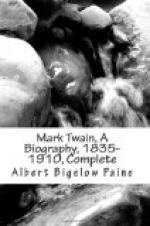Meeting Beard a few days later, Clemens mentioned the matter and said:
“So if you make the pictures, you hang with me.”
But pictures were not required. It was published in the North American Review for February, 1901, as the opening article; after which the cyclone. Two storms moving in opposite directions produce a cyclone, and the storms immediately developed; one all for Mark Twain and his principles, the other all against him. Every paper in England and America commented on it editorially, with bitter denunciations or with eager praise, according to their lights and convictions.
At 14 West Tenth Street letters, newspaper clippings, documents poured in by the bushel—laudations, vituperations, denunciations, vindications; no such tumult ever occurred in a peaceful literary home. It was really as if he had thrown a great missile into the human hive, one-half of which regarded it as a ball of honey and the remainder as a cobblestone. Whatever other effect it may have had, it left no thinking person unawakened.
Clemens reveled in it. W. A. Rogers, in Harper’s Weekly, caricatured him as Tom Sawyer in a snow fort, assailed by the shower of snowballs, “having the time of his life.” Another artist, Fred Lewis, pictured him as Huck Finn with a gun.
The American Board was naturally disturbed. The Ament clipping which Clemens had used had been public property for more than a month—its authenticity never denied; but it was immediately denied now, and the cable kept hot with inquiries.
The Rev. Judson Smith, one of the board, took up the defense of Dr. Ament, declaring him to be one who had suffered for the cause, and asked Mark Twain, whose “brilliant article,” he said, “would produce an effect quite beyond the reach of plain argument,” not to do an innocent man an injustice. Clemens in the same paper replied that such was not his intent, that Mr. Ament in his report had simply arraigned himself.
Then it suddenly developed that the cable report had “grossly exaggerated” the amount of Mr. Ament’s collections. Instead of thirteen times the indemnity it should have read “one and a third times” the indemnity; whereupon, in another open letter, the board demanded retraction and apology. Clemens would not fail to make the apology—at least he would explain. It was precisely the kind of thing that would appeal to him—the delicate moral difference between a demand thirteen times as great as it should be and a demand that was only one and a third times the correct amount. “To My Missionary Critics,” in the North American Review for April (1901), was his formal and somewhat lengthy reply.
“I have no prejudice against apologies,” he wrote. “I trust I shall never withhold one when it is due.”
He then proceeded to make out his case categorically. Touching the exaggerated indemnity, he said:
To Dr. Smith the “thirteen-fold-extra” clearly stood for “theft and extortion,” and he was right, distinctly right, indisputably right. He manifestly thinks that when it got scaled away down to a mere “one-third” a little thing like that was some other than “theft and extortion.” Why, only the board knows!




